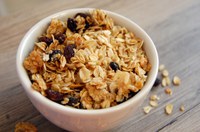Prairie Fare: May is National Bike Month
(Click an image below to view a high-resolution image that can be downloaded)
By Julie Garden-Robinson, Food and Nutrition Specialist
NDSU Extension
“Use your gears,” my husband called back over his shoulder.
That’s easy for him to say, I thought to myself. He can figure out mechanical things almost immediately.
We were trying our new bikes, which have four shifting mechanisms, one pair on each side of the handlebars. I had been riding around our very flat neighborhood, so I had a little practice but not enough.
As we rode on a paved trail, we discovered a chunk of the trail was closed. I wasn’t expecting this. He headed off the path into some thick grass up an incline. I followed him and discovered quickly that I had some muscles that had not been used in a long time, if ever.
I think my tongue was nearly touching the ground as I tried to pedal.
I am a little competitive, however, and the “rabbit” on the bike in front of me was not going to beat me, the “tortoise,” in the long run. Actually, I nearly ran over a real rabbit in the tall grass, but I knew how to use my brakes.
“Shift to two on the left and three on the right,” he said. That helped.
When we got back on pavement and reached the top of the hill, I appreciated the reward of flying downhill. I think I have this new way of shifting figured out now.
We were careful on our first trail ride, and, of course, we wore our helmets. My bright green helmet would be hard to miss.
The League of American Bicyclists has sponsored “National Bike Month” every May since 1956.
As I learned from the hours I spent biking as a kid, cycling is fun. If you bike instead of drive, you can save money on gas and explore your community in a new way.
Cycling also has health benefits. It is low-impact exercise that helps strengthen muscles, including our all-important heart muscle, and it can help with joint flexibility. Burning calories through exercise can help with weight management.
If you have had a rough day, a bike ride can help decrease stress and, potentially, improve mental health.
Bike riding is becoming increasingly popular, and motorists and bike riders need to take precautions. When a bike and a car crash, the car may get a dent, but the bicyclist may not survive. Motorists need to be especially vigilant, giving bicyclists room and not passing too closely. Bicyclists need to follow the rules of the road, too.
In 2016, 816 bicyclists were killed in the U.S., according to the U.S. Department of Transportation (USDOT). That accounts for about 2 percent of all traffic deaths. Most of the bike-related deaths occurred between 6 and 9 p.m. in cities.
If you are inspired to try bicycling, remember these tips adapted from the USDOT and Consumer Reports:
- Ride a bike that fits you. A bike that is too large for you is especially risky.
- Wear a helmet that fits you properly. It should be level on your head, with the front edge no more than about an inch above your eyebrows. The strap should fit closely under your chin. Wearing a properly adjusted helmet can reduce the risk of head injury in case of a fall.
- Be sure your bike works, especially the brakes.
- Be sure you are visible, especially at night. Wear bright clothing and/or reflective gear. Have a white front light and red rear light.
- Be sure your shoelaces are tied and your pant legs do not get caught in the chain.
- When you are on a bike, follow the rules of the road associated with vehicles. Ride with traffic, not against it. Stop at stop signs.
- Watch out for potholes and other obstacles in your path.
- Avoid distractions and pay attention while riding a bike. As with driving a vehicle, do not text while riding a bike. Avoid listening to music with headphones.
- Explore options for bike mirrors. Various options are available that may attach to handlebars, helmets or even sunglass lenses. At least look over your shoulder to be aware of what’s behind you.
- If bicyclists share a trail with pedestrians, be sure to communicate with the pedestrians. For example, if you are passing on the left, let them know.
When we reached our neighborhood, I got my second wind. Yes, this tortoise made it home sooner than the rabbit. Maybe my husband let me win so I would go bike riding again. I think we both limped into the house.
Regardless of your fitness regimen, keep yourself well-hydrated and try this easy-to-make trail snack to enjoy after a bike ride or hike this summer.
Slow Cooker Honey Granola
4 c. old-fashioned oats, uncooked
6 Tbsp. honey
1/2 c. flax
1 c. bran cereal
1 c. raisins
1/4 c. canola oil
Put all ingredients into a 6-quart slow cooker and mix well. Put the cover on a little bit askew and cook on low for around three hours, stirring occasionally. Let cool on parchment paper and store in an airtight container for up to two weeks.
Makes 24 servings. Each (1/4-cup) serving has 130 calories, 4 grams (g) fat, 3 g protein, 23 g carbohydrate, 2 g fiber and 10 milligrams sodium.
(Julie Garden-Robinson, Ph.D., R.D., L.R.D., is a North Dakota State University Extension food and nutrition specialist and professor in the Department of Health, Nutrition and Exercise Sciences. Follow her on Twitter @jgardenrobinson)
NDSU Agriculture Communication - May 17, 2018
| Source: | Julie Garden-Robinson, 701-231-7187, julie.garden-robinson@ndsu.edu |
|---|---|
| Editor: | Ellen Crawford, 701-231-5391, ellen.crawford@ndsu.edu |



